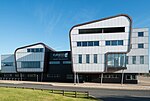Barrow/Walney Island Airport
AC with 0 elementsAirports in EnglandAirports in LancashireBarrow-in-FurnessBuildings and structures in Barrow-in-Furness ... and 4 more
FurnessTransport in Barrow-in-FurnessTransport in CumbriaUse British English from May 2013

Barrow/Walney Island Airport (IATA: BWF, ICAO: EGNL) (formerly RAF Walney Island) is located on Walney Island, 1.5 NM (2.8 km; 1.7 mi) northwest of the centre of Barrow-in-Furness, Cumbria, England. The airport is owned by BAE Systems, who operate private communication flights to locations across the United Kingdom and expanded the airport with new infrastructure and terminal buildings in 2018. The Lakes Gliding Club also operates out of the airport.
Excerpt from the Wikipedia article Barrow/Walney Island Airport (License: CC BY-SA 3.0, Authors, Images).Barrow/Walney Island Airport
England Coast Path,
Geographical coordinates (GPS) Address Nearby Places Show on map
Geographical coordinates (GPS)
| Latitude | Longitude |
|---|---|
| N 54.128611111111 ° | E -3.2675 ° |
Address
England Coast Path
England Coast Path
LA14 3XZ
England, United Kingdom
Open on Google Maps








